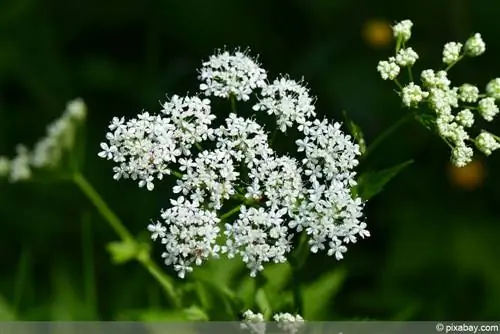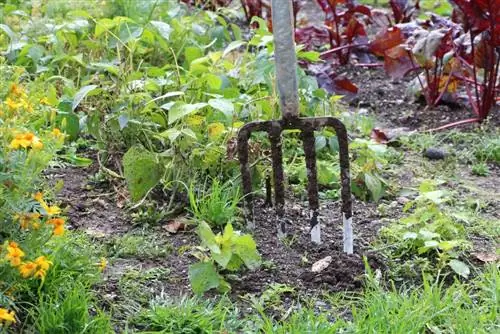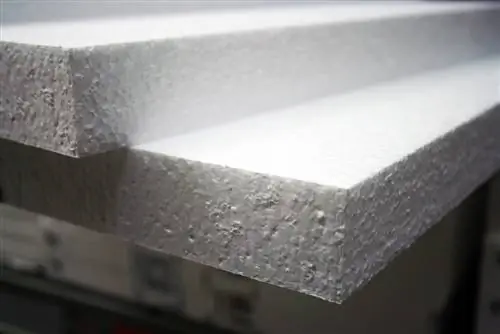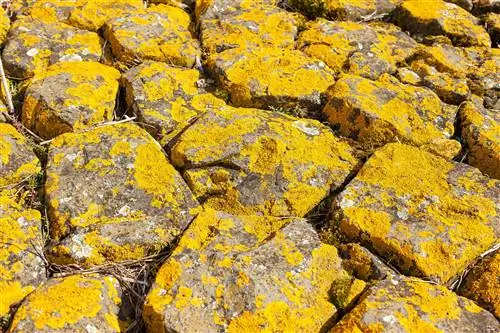- Author admin [email protected].
- Public 2023-12-17 03:39.
- Last modified 2025-01-24 12:45.
It starts with a single plant and can quickly develop into a dense carpet - but the groundweed spreads sustainably in a very short time and is difficult to remove. A single piece of root is enough for the tree to sprout again. However, with the right means and measures, it can still be combated effectively.
Identifying gopherfish
The leaves of the tree drop are reminiscent of the leaves of the elderberry. The plants usually grow up to 30 centimeters high, but can also reach sizes of 100 centimeters. They bloom white, although the flowers are rather inconspicuous and have no bracts. The best way to recognize the greedweed is by its spread. It grows very quickly and in dense carpets.
Fight early
Since tree drip spreads so quickly, it should be combated as early as possible. As soon as the first shoots appear in spring, you need to act quickly. This prevents the weeds from spreading uncontrollably and damaging other plants.
Dissemination
Gedweed spreads both through seeds and root runners. The groups of plants can therefore increase in size and spread throughout the garden thanks to the wind.
Superficial distance
Superficial removal is not a permanent solution, but it is helpful. This weakens the plant - even if only slightly -, reduces growth and prevents the formation of seeds. It makes sense to remove above-ground greenery in all accessible areas with a lawn mower, a lawn edger or, in small accumulations, with scissors. Alternatively, it can also be torn off just above the ground.
Removing roots
If root remnants remain in the soil, the gourd can still develop new shoots up to a year later. For complete removal it is therefore important to remove all rhizomes.
We recommend the following steps:
- If necessary, water the soil a little so that the soil can be worked more easily.
- Dig and dig the soil to a depth of 30 centimeters.
- Loose the individual pieces of soil and sieve very finely so that no pieces of roots remain.
This measure should be done very thoroughly so as not to leave any rhizome residue in the soil. Otherwise the effort will be in vain and the groundweed will only spread again in the dug up soil.
Choke tree drip
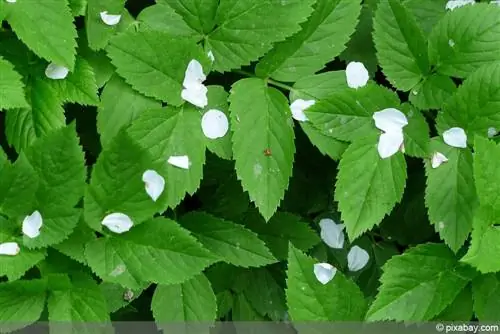
In some cases it is not possible to dig up the soil and remove all the roots of the tree drip, for example on tree slices, around bushes and in dense growth on other plants.
In these circumstances, it can make sense to smother the gopher. This can be done with the following steps:
- Chop off, cut down or mow the goosegrass. The stems should be shortened as close to the ground as possible.
- Lay out impermeable foil, thick cardboard or garden fleece. Gaps and holes should be avoided.
- Cover the foil thickly with gravel or bark mulch. It should be at least five to ten centimeters.
- Carry out regular checks. Even individual shoots of the tree drip should be removed immediately. Since it grows very quickly from spring to autumn, checks should be carried out weekly.
- Keep patience! The gourd is very persistent and can sprout again after many months to a year if given the opportunity. The cover should therefore remain on the tree disc for at least one to two years in order to kill the weeds effectively and sustainably.
Disposing of gooseflesh
If the tree drop ends up on the compost, it will most likely only sprout again and distribute seeds. It is therefore better to dispose of it with organic waste or household waste. If the plants have already formed their caraway-like seeds, special care should be taken when removing and disposing of them. In these cases it is advisable to burn the plants and seeds. Alternatively, the seed-bearing shoots can be carefully cut off and packed directly in a bag or bag. This reduces the risk of the seeds spreading into the surrounding area. Even with such thorough removal and disposal, it can still happen that individual seeds have already been spread by wind, animals or gardening. It is therefore important to continue to carry out regular checks.
Tip:
The tree drip can also be used as fertilizer if a plant manure is made from it.
Introduce competing plants
Heavy-consuming and fast-growing plants, such as potatoes, eggplants and zucchini, compete for water, nutrients and space for the gourd. This can slow down the growth of weeds. To prepare the soil and as a simple way to combat it, we recommend growing heavy feeders with dense foliage. A nice side effect of this variant is the subsequent harvest.
Use herbicides
The use of herbicides should be a last resort because it will also affect useful or ornamental plants and pollute the soil. Therefore, care should be taken when choosing gentle products. In addition, herbicides should not be used near other plants.
Introduce root barriers
Using root barriers and lawn edging stones around trees and shrubs, beds and borders makes it easier to control weeds in general and groundweed in particular. The spread via root runners is reduced. However, seeds can still be distributed in the area. They are therefore only useful if the tree drip is kept as short as possible and flowers are removed immediately.
Giersch: annoying but delicious
Before groundweed was considered a nuisance weed, it was used as a spicy herb, leafy vegetables and in salads, and was also used in herbal medicine. So the plants don't have to be thrown away, they can also end up on your plate.

